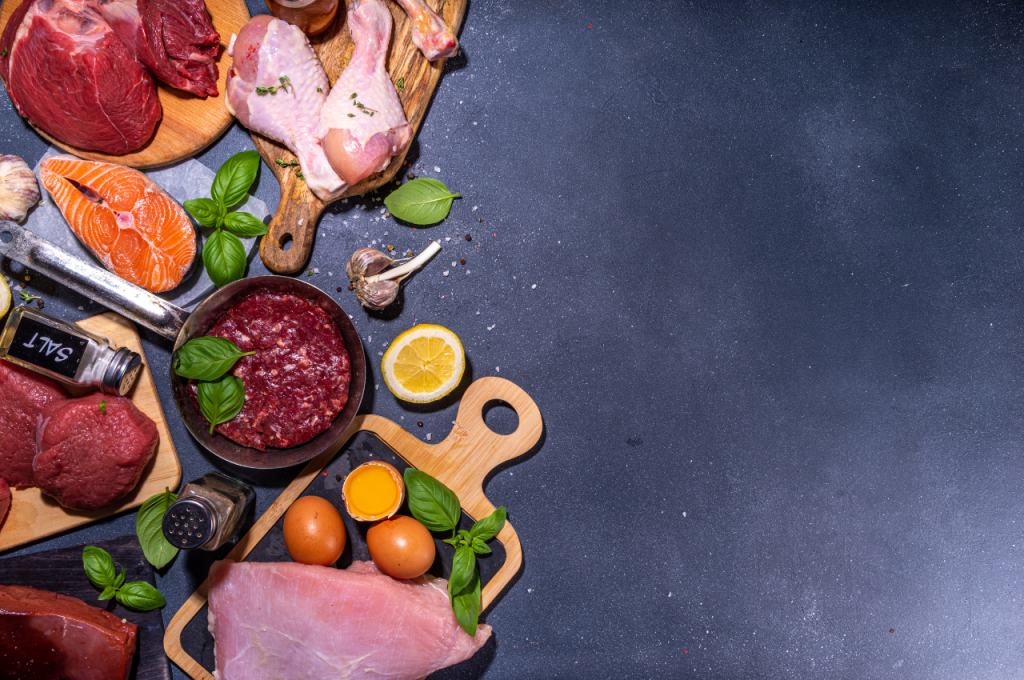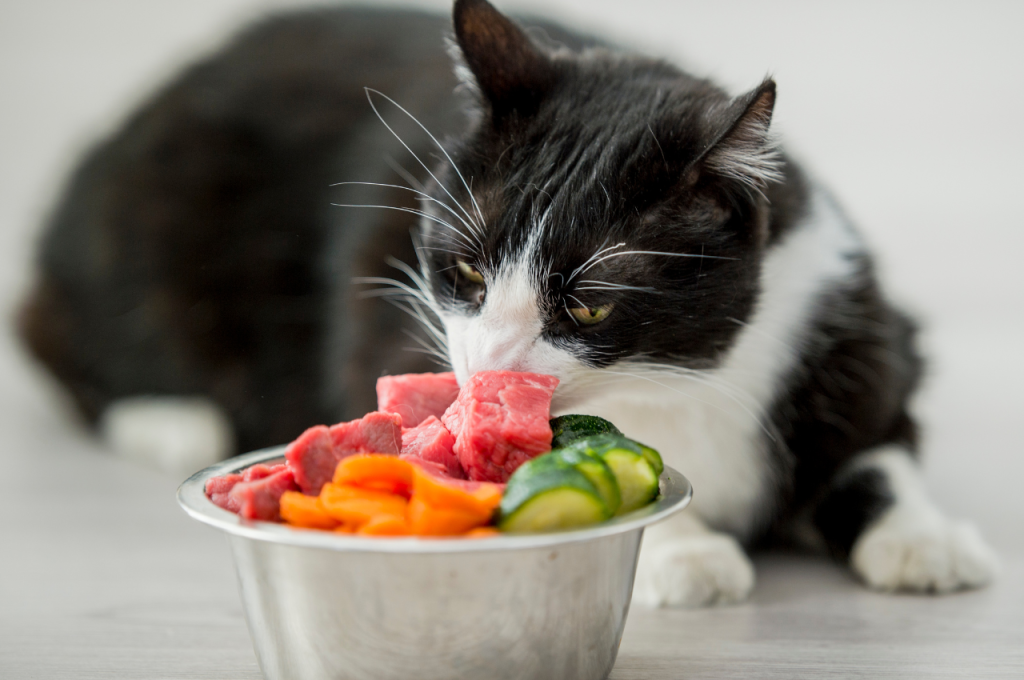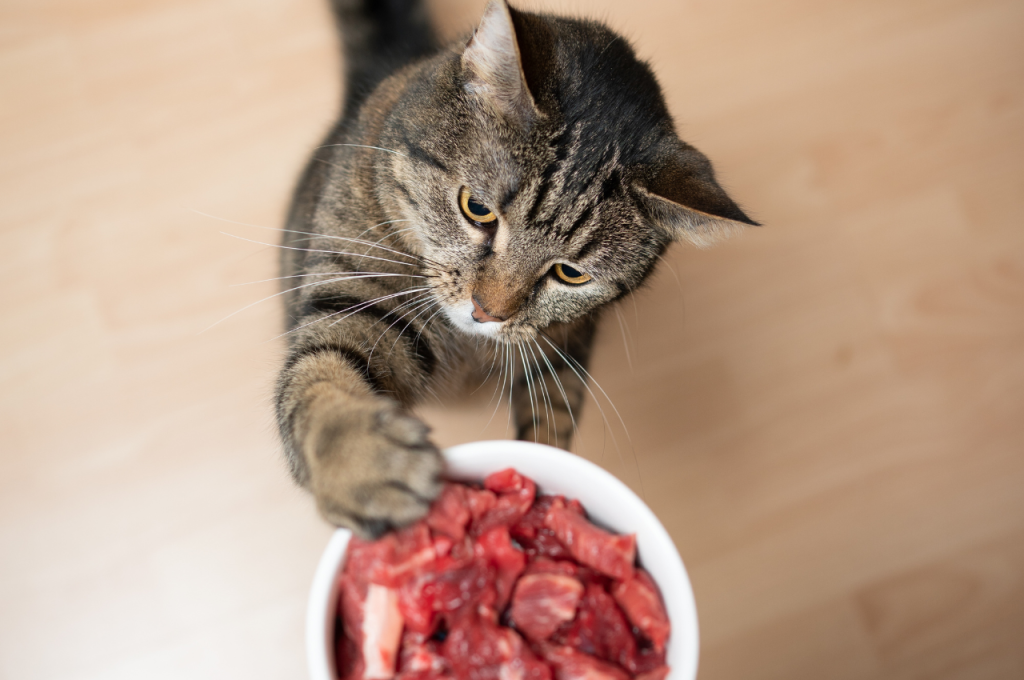When it comes to the best raw cat food, many pet owners are turning to this natural and nutritious alternative. Did you know that feeding cats a raw diet can help them mimic the eating habits of their ancestors? With a high meat content and limited processing, raw cat food aims to provide feline friends with all the essential nutrients they need to thrive.
Raw cat food has gained popularity due to its potential health benefits. Cats are obligate carnivores, meaning their bodies require a diet primarily composed of meat. By feeding them a raw diet, pet owners can provide more species-appropriate nutrition that supports their overall well-being. Additionally, studies have shown that a raw diet can improve digestion, promote healthy weight management, and reduce the risk of certain health problems, such as urinary tract problems.
When it comes to providing optimal nutrition for your cat, raw cat food is an excellent choice. With its high-quality ingredients and minimal processing, raw cat food ensures that your feline friend gets the essential nutrients they need. Raw cat food promotes healthy digestion, reduces allergies, and improves coat quality.
Types of Raw Cat Food
When it comes to raw cat food, there are several types to choose from. Each type offers its unique benefits, and the best choice for your cat depends on their individual needs and preferences. Here are some of the most common types of raw cat food:

Commercially Prepared Raw Cat Food
Commercially prepared raw cat food is a convenient option for cat owners who want to ensure their pets are getting a balanced and complete diet. These products are often available in freeze-dried or frozen formats and contain a mix of meat, organs, bones, and sometimes fruits and vegetables. Many commercially prepared raw cat food brands undergo rigorous testing to ensure they meet the nutritional requirements set by regulatory bodies.
When choosing a commercially prepared raw cat food, it’s important to look for brands that use high-quality ingredients and have a good reputation. Read the labels carefully to understand the ingredients and their sources. Additionally, consider your cat’s dietary restrictions and preferences, such as grain-free or limited ingredient options.
Introducing commercially prepared raw cat food into your cat’s diet allows for easier portion control and ensures that they are receiving a balanced and nutritionally complete meal. However, it is always recommended to consult with your veterinarian before making any significant changes to your cat’s diet.
Homemade Raw Cat Food
For cat owners who prefer a more hands-on approach to their pet’s nutrition, homemade raw cat food can be a viable option. Making raw cat food at home allows for complete control over the ingredients, making it easier to accommodate any dietary restrictions or preferences your cat may have.
When preparing homemade raw cat food, it’s crucial to consult with a veterinary nutritionist or follow well-researched recipes to ensure your cat is receiving all the necessary nutrients. A balanced homemade raw cat food diet typically consists of a mix of raw meat (including bones and organs), as well as supplements to provide any missing essential nutrients. It’s important to note that providing a nutritionally complete homemade raw cat food diet can be challenging and time-consuming, requiring careful planning and preparation.
If you choose to provide homemade raw cat food, it’s essential to work closely with your veterinarian to ensure your cat’s nutritional needs are met. Regular consultations and blood tests can help monitor your cat’s health and make any necessary adjustments to their diet.
Prey Model Raw (PMR) Diet
The Prey Model Raw (PMR) diet is based on the idea of feeding cats a diet that closely mimics what they would eat in the wild. This approach avoids the use of any fruits, vegetables, or supplements and focuses solely on the raw meat, bones, and organs that cats would consume when hunting prey.
Proponents of the PMR diet argue that cats have evolved to require a diet that consists solely of animal products. They believe that this type of diet provides all the necessary nutrients, including essential vitamins and minerals, naturally occurring in raw prey. However, it’s important to note that PMR diets require careful planning to ensure cats are receiving all the essential nutrients they need.
As with any raw diet, consulting with a veterinarian is crucial to ensure the PMR diet is appropriate for your cat’s individual needs and to monitor their health while on this diet.
Partial Raw Feeding
Another option for cat owners is partial raw feeding. This involves incorporating raw food into your cat’s diet alongside their regular commercial cat food. Partial raw feeding allows for the benefits of raw nutrition while still providing the convenience and peace of mind of commercial cat food.

This approach can be especially useful for cat owners who may be hesitant about completely transitioning to a raw diet or for cats who have specific dietary needs or preferences. By gradually increasing the proportion of raw food in your cat’s diet, you can customize their meals and observe how they respond to the changes.
It’s important to note that even with partial raw feeding, it’s crucial to provide a balanced and nutritionally complete diet for your cat. Consultation with a veterinarian can help ensure you are meeting your cat’s nutritional needs.
Choosing the Best Raw Cat Food
With so many options available, it can be challenging to choose the best raw cat food for your feline companion. Here are some factors to consider when making your decision:
Nutritional Balance
First and foremost, it’s crucial to ensure that the raw cat food you choose provides complete and balanced nutrition for your cat. Look for products that meet the nutritional guidelines outlined by regulatory bodies and provide the necessary vitamins, minerals, and essential nutrients your cat needs for optimal health.
Consider your cat’s age, weight, activity level, and any specific dietary requirements or restrictions they may have. For example, kittens have different nutritional needs than adult cats and senior cats may benefit from specific supplements or ingredients that support joint health.
If you are feeding homemade raw cat food, consult with a veterinary nutritionist to ensure your cat’s diet is nutritionally balanced and meets their specific needs.
Quality of Ingredients
When choosing raw cat food, pay close attention to the quality of the ingredients used. Look for products that use human-grade or high-quality animal proteins, such as chicken, turkey, beef, or fish. Avoid products that contain fillers, artificial additives, or meat by-products.
Additionally, check the sourcing and processing methods of the ingredients used. Look for products that use ethically sourced meat, free from antibiotics and hormones. Proper handling and quality control measures during the manufacturing process are also important to ensure the safety and integrity of the product.
Digestibility
Raw cat food should be easily digestible for your feline friend. Look for products that include digestive enzymes or probiotics, which can help support healthy digestion and nutrient absorption. Additionally, consider the texture and consistency of the raw food to ensure it is suitable for your cat.
Transitioning and Monitoring
When transitioning your cat to a raw diet, it’s essential to do so gradually. Introduce small amounts of raw food alongside their regular diet, gradually increasing the proportion of raw food over time. This gradual transition allows your cat’s digestive system to adjust and reduces the chances of gastrointestinal upset.

Monitor your cat closely throughout the transition and after the switch to raw cat food. Look for any signs of discomfort, digestive issues, or changes in behavior or appearance. If you notice any concerns, consult with your veterinarian to ensure your cat’s health and well-being.
Frequently Asked Questions
Here are some common questions about the best raw cat food:
1. What are the benefits of feeding my cat raw food?
Feeding your cat raw food offers several benefits. Firstly, it closely mimics their natural diet, providing them with the essential nutrients they need to thrive. Raw food can also improve digestion, reduce the likelihood of allergies, and promote a healthier coat. Additionally, many cat owners find that their cats have increased energy levels and better overall health when fed a raw diet.
However, it’s essential to consult with your veterinarian before switching your cat to a raw food diet to ensure it meets their specific nutritional needs.
2. Can I make my raw cat food at home?
Yes, you can make raw cat food at home, but it requires careful preparation and knowledge of feline nutritional needs. It’s crucial to include a balance of meat, bones, and organs to ensure your cat receives all the necessary nutrients. Many cat owners choose to follow recipes created by veterinary nutritionists to ensure their homemade raw cat food is nutritionally complete.
If you decide to make your raw cat food, it’s important to handle and store the ingredients properly to prevent the growth of harmful bacteria. Consult with your veterinarian to ensure you are meeting your cat’s specific dietary requirements.
3. Can all cats safely eat raw food?
While many cats can safely eat raw food, it may not be suitable for every cat. Some cats have underlying health conditions or weakened immune systems that make them more susceptible to foodborne illnesses. Additionally, kittens, pregnant cats, and senior cats may have different nutritional needs that need to be taken into consideration when feeding them raw food.
Before transitioning your cat to a raw food diet, it’s important to consult with your veterinarian to determine if it’s the right option for your cat’s individual needs.
4. How do I introduce my cat to raw food?
Introducing your cat to raw food should be done gradually to allow their digestive system to adjust. Start by mixing a small amount of raw food with their current diet and gradually increase the proportion of raw food over time. Monitor your cat’s response to the new diet and make adjustments as necessary.
It’s also important to note that some cats may be more resistant to dietary changes, so patience and persistence are key. If you encounter any difficulties, consult with your veterinarian for guidance.
Conclusion
Choosing the best raw cat food requires careful consideration of your cat’s individual needs, preferences, and overall health. Whether you opt for commercially prepared raw cat food or decide to make homemade raw meals, it’s important to ensure that the food is nutritionally balanced, of high quality, and easily digestible for your cat. Remember to consult with your veterinarian throughout the process to ensure the transition to a raw diet is done safely and in the best interest of your feline companion.
Feeding your cat a raw diet can provide them with the nutrition they need for optimal health and well-being. With the right choice of raw cat food and proper monitoring, you can give your furry friend the best possible diet that aligns with their instincts.
